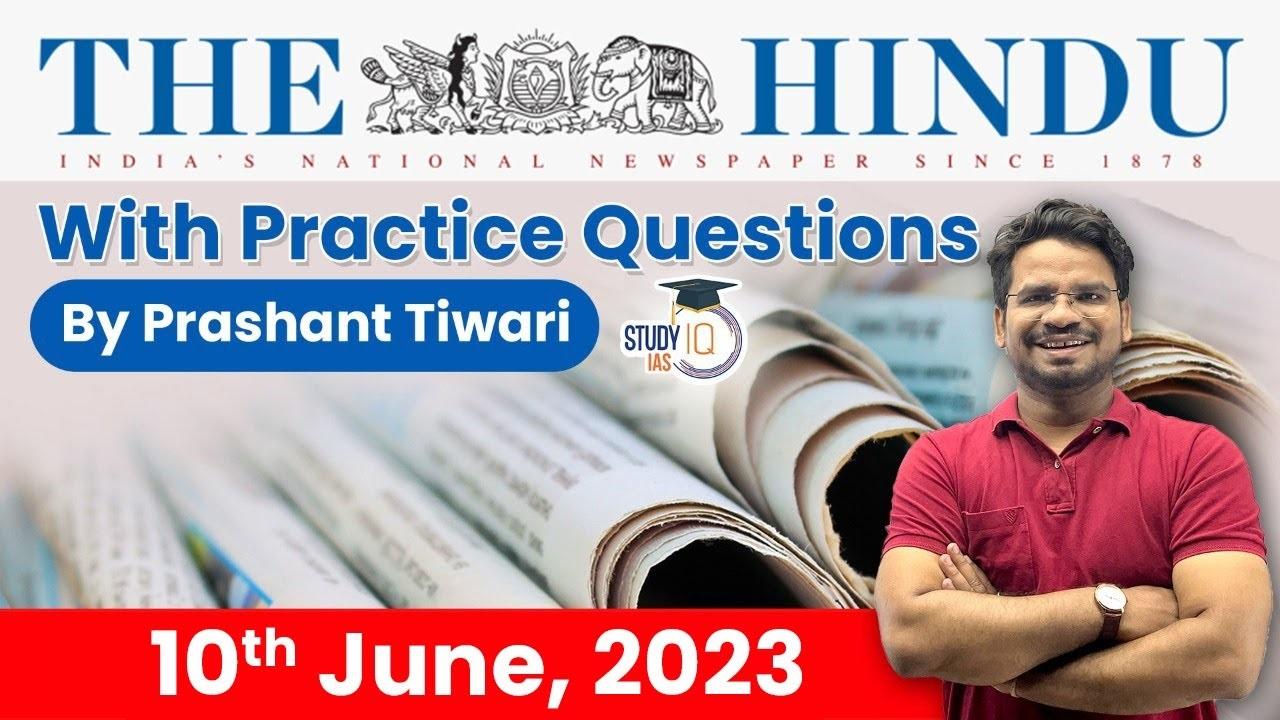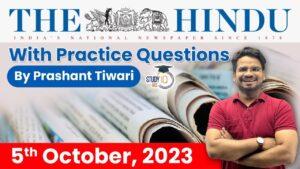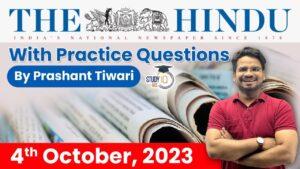The Hindu Newspaper Analysis for UPSC

The Hindu Newspaper Analysis 9 June 2023
- The Indian economy is now on “autopilot” mode and will grow steadily in the range of 6.5-7% till 2030, even without further reforms, Chief Economic Adviser (CEA) V. Anantha Nageswaran asserted on Friday, adding that the initial assessment of 7.2% GDP growth for 2022-23 could be an underestimate.
- “seven or 10 or 15 years like China did between 1979 and 2008” without “running into overheating problems”.
- About
- The Chief Economic Adviser (CEA) is a post in the Government of India and is equivalent to the rank of Secretary to the Government of India.
- The CEA is the ex-officio cadre controlling authority of the Indian Economic Service: The CEA is head of Economic Division of the Department of Economic Affairs, Ministry of Finance
- Role of the CEA: The extent to which the Government takes into account the advice of the Chief Economic Adviser has generally been considered to be open-ended.
- The main role of CEA is to produce an Economic Survey.
- Who was the first Chief Economic Advisor of India?
- Renowned economist JJ Anjaria (1908-70), who co-authored the classic text on Indian agricultural economics, ‘The Indian Rural Problem’, was the first Chief Economic Advisor of India.
- He held the position from 1956 to 1961, during the tenure of former Prime Minister Jawaharlal Nehru.

- Mekedatu Project:
- The Rs. 9,000 crore project aims to store and supply water for drinking purposes for the Bengaluru city. Around 400 megawatts (MW) of power is also proposed to be generated through the project.
- It was first approved by the Karnataka state government in 2017.
- It received approval from the erstwhile Ministry of Water Resources for the detailed project report and is awaiting approval from the Ministry of Environment, Forest and Climate Change (MoEFCC).
- The approval from MoEFCC is crucial because 63% of the forest area of the Cauvery Wildlife Sanctuary will be submerged.
- In 2018, Tamil Nadu approached the Supreme Court (SC) against the project even if Karnataka had held that it would not affect the flow of water to Tamil Nadu.
- In June 2020, during the Cauvery Water Management Authority’s meeting, Tamil Nadu reiterated its opposition to the project.
- Reasons for Opposition by Tamil Nadu:
- Tamil Nadu is opposed to any project being proposed in the upper riparian unless it was approved by the SC.
- Karnataka has no right to construct any reservoir on an inter-state river without the consent of the lower riparian state i.e. Tamil Nadu in this case.
- The project is against the final order of the Cauvery Water Disputes Tribunal (CWDT) in which the SC held that no state can claim exclusive ownership or assert rights to deprive other states of the waters of inter-state rivers.
- River Cauvery (Kaveri):
- It is known as ‘Ponni’ in Tamil, and it is the fourth largest river of southern India.
- It is a sacred river of southern India.
- It rises on Brahmagiri Hill of the Western Ghats in southwestern Karnataka state, flows in a southeasterly direction through the states of Karnataka and Tamil Nadu, and descends the Eastern Ghats in a series of great falls and drains into Bay of Bengal through Pondicherry.
- Some of its tributaries are Arkavathi, Hemavathi, Lakshmana Theertha, Shimsa, Kabini and Harangi.

- The Electricity Act 2003 provided the framework for the dismantling of the State Electricity Boards and the separation of generation, transmission and distribution into separate companies. Electricity generation was delicensed, while transmission and distribution remained licenced and regulated activities.
- The Distribution Licensee (Discom) has the universal service obligation of supplying electricity to meet the full demand of every consumer (existing and new), in its licence area. Therefore, the Discom has the responsibility of projecting demand growth and making arrangements for reliable electricity supply.
- Cross subsidisation is the difference in the pricing strategy for two groups of consumers. It is the practice of paying a set of consumers greater prices to fund reduced costs for another group.

- The visit has helped in underlining the real priorities — the “game changers” which can transform the economic landscape of the sub-region, such as hydropower projects to supply energy to India (and eventually to Bangladesh), infrastructure, access to Indian river transport, innovative tourism circuits, and better connectivity.
- Enhancing digital financial connectivity is another crucial development.
- The real challenge for Nepal is to depoliticise cooperation with India, especially in water resources cooperation, improve the quality of democracy and governance at home, and check unbridled corruption, which is alarming even by South Asian standards.
- For India, it may be necessary to address the perception in Nepal that it is no longer a foreign policy priority, and to give a sense of ownership, equality and credit for major forward movement in sectors such as hydropower to parties across the political spectrum, rather than only to the government of the day.

- If the Centre succeeds in its marquee Jal Jeevan Mission (JJM), a nearly ₹3.6 trillion enterprise to provide piped potable water to all of India, it would avert close to 4,00,000 deaths from diarrhoea, a modelling study by the World Health Organization (WHO) and commissioned by the Jal Shakti Ministry, said on Friday.
- Additionally, this would avoid 14 million DALYs (Disability Adjusted Life Years) from diarrhoea, save close to $101 billion and 66.6 million hours every day of time that would otherwise have been spent — predominantly by women — collecting water, the authors of the study noted.
- A DALY represents the loss of the equivalent of one year of full health and are a way to account for the years of life lost due to premature mortality (YLLs) and the years lived with a disability (YLDs), due to prevalent cases of a disease or a health condition, in a population.
- Currently about 12.3 crore rural households, or 62%, have piped water connections up from 3.2 crore or about 16.6% from 2019 when the scheme was launched.
- The Centre has claimed that it will achieve 100% coverage by 2024. A fully functional tap water connection is defined as a household getting at least 55 litres of per capita per day of potable water all through the year.
- Five States including Gujarat, Telangana, Goa, Haryana, and Punjab and 3 Union Territories — Andaman & Nicobar Islands, Daman Diu & Dadra Nagar Haveli and Puducherry have reported 100% coverage. Himachal Pradesh at 98.87%, followed by Bihar at 96.30%


 The Hindu Newspaper Analysis 6 October 2...
The Hindu Newspaper Analysis 6 October 2...
 The Hindu Newspaper Analysis 5 October 2...
The Hindu Newspaper Analysis 5 October 2...
 The Hindu Newspaper Analysis 4 October 2...
The Hindu Newspaper Analysis 4 October 2...

















